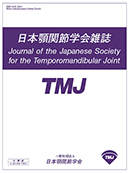All issues

Volume 26 (2014)
- Issue 3 Pages 183-
- Issue 2 Pages 85-
- Issue 1 Pages 3-
Predecessor
Volume 26, Issue 3
Displaying 1-3 of 3 articles from this issue
- |<
- <
- 1
- >
- >|
proceedings
-
Hiroyuki WAKE, Osamu KOMIYAMA2014 Volume 26 Issue 3 Pages 183-190
Published: December 20, 2014
Released on J-STAGE: February 20, 2015
JOURNAL FREE ACCESSThis article describes liaison treatment between dentists and psychiatrists for patients with temporomandibular disorders (TMD). Psychosomatic disease is considered to lie on the border between physical and mental diseases. Although TMD is considered to be a "dental psychosomatic disease", no clear definition of such disease has been established. In the clinical setting, this term is used in both the narrow and broad senses, with the narrow sense indicating a specific dental disease according to the definition of psychosomatic disease established by the Japanese Society of Psychosomatic Medicine (1991). On the other hand, in the broad sense, the term is used for patients who have a clinically unexplainable symptom and require both psychological and somatic assessment/management. In liaison psychiatric clinics, somatoform disorders are seen in more than 70% of patients with dental psychosomatic disease. TMD is a multi-factorial disorder with psychosocial factors that include the patient's psychological status (such as anxiety and/or depression), personality traits, emotional stress, and psychiatric diseases. It is important to consider each factor in the diagnosis and treatment of TMD. Dentists should make a bio-psychosocial evaluation of patients with TMD and use an interview-based treatment strategy that incorporates listening, acceptance, sympathy, support and reassurance. Medical interviews including psychosocial contents are important for patients with TMD who require liaison treatment with psychiatrists. Caution is required for patients whose dentists cannot find an objective finding following a physical examination or who exhibit a divergence between subjective symptoms and objective findings. Therefore, it is important to distinguish patients who are only able to be treated by a dentist from those who require liaison treatment with a psychiatrist.View full abstractDownload PDF (684K) -
-What psychiatrists ask dentists to do in their practice-Hitoshi MIYAOKA, Hideo MIYACHI2014 Volume 26 Issue 3 Pages 191-195
Published: December 20, 2014
Released on J-STAGE: February 20, 2015
JOURNAL FREE ACCESSFor 30 years, we have cooperated with dentists and oral surgeons in the practice and research of liaison psychiatry. Liaison psychiatrists ask dentists to do the following in their clinical practice: 1. Dentists should not readily explain to patients that their somatic complaints are caused by psychogenesis, stress, or psychosomatic diseases; 2. Dentists should recognize that there are many differential diagnoses of systemic physical disorders in somatic complaints around the oral area without objective findings; 3. The rules of basic medical interviews should be followed; 4. Treatments should be performed after gaining informed consent; 5. Dentists should use psychotropic drugs very carefully; and 6. Choose the best psychiatrists when making referrals.View full abstractDownload PDF (288K)
original articles
-
Tomoaki SHIBUYA, Hiroyuki WAKE, Katsuji TAMAKI, Atsushi SHIMADA, Kiyos ...2014 Volume 26 Issue 3 Pages 196-203
Published: December 20, 2014
Released on J-STAGE: February 20, 2015
JOURNAL FREE ACCESSPurpose: We gathered data and evaluated the conditions associated with patients with occlusal discomfort at multiple institutions. Subjects and Methods: A total of 202 outpatients were recruited, and 180 patients were selected for further evaluation. We designed a questionnaire and analyzed the parameters of sex, age, illness duration, chief complaint, tooth, affected part and state of occlusal discomfort, and past dental treatment before consultation. Results: There were 143 female and 37 male patients, with a median age of 55.0 (42.0, 65.0) years. The median illness duration was 5 (1, 13) months. The most common chief complaint was contact of the intercuspal position. Although the site of occlusal discomfort was often the molars, at times it also presented in the incisors. Additionally, occlusal discomfort was experienced in various parts, not only on one side but also on both sides, and many patients experienced discomfort in their full dental arch. Although metallic prostheses for teeth often cause occlusal discomfort, there were also many cases of occlusal discomfort with natural teeth. In the past, the most common treatment was prosthetic dental care. Conclusion: Although the sex and median age of the patients were the same as those in previous reports, the duration of illness varied. The patients experienced occlusal discomfort not only in the treated teeth but also in the natural teeth of various parts.View full abstractDownload PDF (1007K)
- |<
- <
- 1
- >
- >|